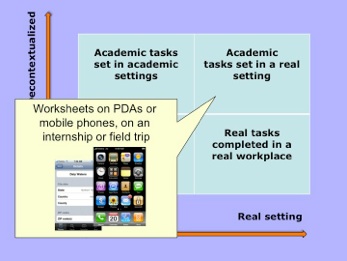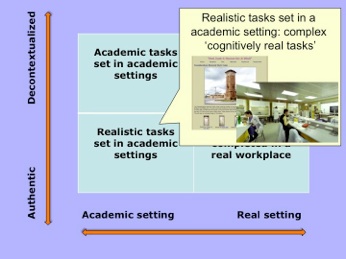Evaluation of Authentic Learning environments
How many elements of authentic learning do I need?
We are often
asked, do you need all the elements of the model to be able to call your
learning environment authentic? Perhaps a better way to think of it is
as a continuum, where you can assess the extent your learning
environment aligns with each characteristic.
You can access an evaluation matrix (pdf) to assist reflection on how well your learning environment aligns with the authentic learning model.
The picture at right demonstrates (in
part) how two quite different courses might be illustrated on the task
dimension of the matrix. The task on the right is more authentic as
judged on all the elements because it provides a realistic and complex
task that requires decision-making by students, and takes a few weeks of
a semester course to complete. The task on the left is a more academic
decontextualised one, with limited resources, taking only minutes or
hours to complete.
More Reading
- Herrington, J., Reeves, T.C & Oliver, R. (2010). A guide to authentic e-learning London and New York: Routledge. CHAPTER 3 and CHAPTER 8
- Reeves, T.C., & Hedberg, J.G. (2003). Interactive learning systems evaluation. Englewood Cliffs, N.J.: Educational Technology Publications.
- Leppisaari, I., Vainio, L., & Herrington, J. (2009). Developing authentic e-learning through virtual benchmarking. In C. Fulford & G. Siemens (Eds.), Proceedings of EdMedia 2009 (pp. 4423-4432). Chesapeake, VA: AACE.
An authentic learning matrix
Real or realistic? Authentic learning occurs in classrooms
Can a learning environment be
called authentic if it is completed in a classroom or on campus? Yes,
we think so! Authentic does not necessarily mean real (as in practicums
and internships). As a pedagogical model, authentic learning means that
realistic tasks set in academic settings can challenge students to think
and solve problems just as professionals do in the real world.
Video: 3:27 minutes
More Reading:
- Herrington, J., Reeves, T.C., & Oliver, R. (2007). Immersive learning technologies: Realism and online authentic learning. Journal of Computing in Higher Education, 19(1), 65-84.
- Herrington, J., Oliver, R., & Reeves, T.C. (2003). Patterns of engagement in authentic online learning environments. Australian Journal of Educational Technology, 19(1), 59-71.
- Petraglia, J. (1998). Reality by design: The rhetoric and technology of authenticity in education. Mahwah, NJ: Lawrence Erlbaum Associates.

Quadrant 1
Academic tasks set in academic settings

Quadrant 2
Academic tasks set in a real setting

Quadrant 3
Real tasks set in a real workplace

Quadrant 4
Realistic tasks set in an academic setting
Further resources
Link to sites, books , papers and other resources on authentic learning and authentic e-learning
